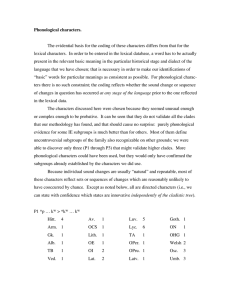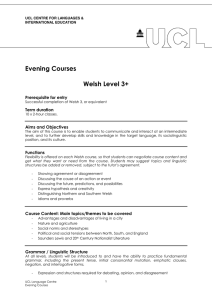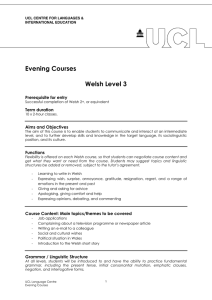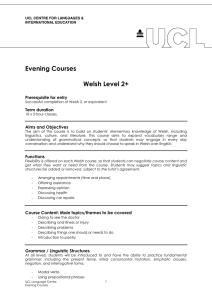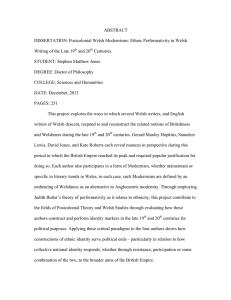Morphological characters.
advertisement
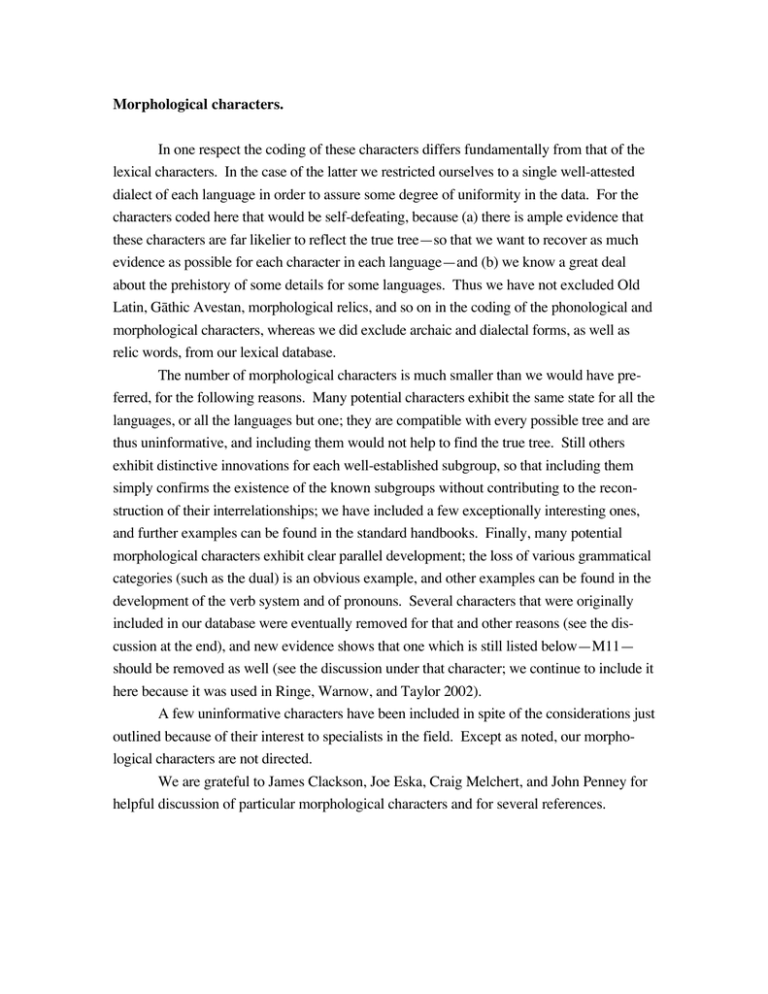
Morphological characters. In one respect the coding of these characters differs fundamentally from that of the lexical characters. In the case of the latter we restricted ourselves to a single well-attested dialect of each language in order to assure some degree of uniformity in the data. For the characters coded here that would be self-defeating, because (a) there is ample evidence that these characters are far likelier to reflect the true tree—so that we want to recover as much evidence as possible for each character in each language—and (b) we know a great deal about the prehistory of some details for some languages. Thus we have not excluded Old Latin, G3thic Avestan, morphological relics, and so on in the coding of the phonological and morphological characters, whereas we did exclude archaic and dialectal forms, as well as relic words, from our lexical database. The number of morphological characters is much smaller than we would have preferred, for the following reasons. Many potential characters exhibit the same state for all the languages, or all the languages but one; they are compatible with every possible tree and are thus uninformative, and including them would not help to find the true tree. Still others exhibit distinctive innovations for each well-established subgroup, so that including them simply confirms the existence of the known subgroups without contributing to the reconstruction of their interrelationships; we have included a few exceptionally interesting ones, and further examples can be found in the standard handbooks. Finally, many potential morphological characters exhibit clear parallel development; the loss of various grammatical categories (such as the dual) is an obvious example, and other examples can be found in the development of the verb system and of pronouns. Several characters that were originally included in our database were eventually removed for that and other reasons (see the discussion at the end), and new evidence shows that one which is still listed below—M11— should be removed as well (see the discussion under that character; we continue to include it here because it was used in Ringe, Warnow, and Taylor 2002). A few uninformative characters have been included in spite of the considerations just outlined because of their interest to specialists in the field. Except as noted, our morphological characters are not directed. We are grateful to James Clackson, Joe Eska, Craig Melchert, and John Penney for helpful discussion of particular morphological characters and for several references. 2 M1 organization of the verb system Hitt. 1a Av. 2 Luv. 1b Goth. 5 Arm. 2 OCS 2 Lyc. 1b ON 5 Gk. 2 Lith. 4 TA 3 OHG 5 Alb. 2 OE 5 OPer. 2 Welsh 7 TB 3 OI 6 OPru. 4 Osc. 2 Ved. 2 Lat. 2 Latv. 4 Umb. 2 1 one stem for each lexical verb 1a two conjugations with partly different endings in the active 1b single conjugation 2 present–aorist–perfect contrast present or clearly reconstructable 3 basic contrast between present, subjunctive, and preterite stems; formation of present and subjunctive stems largely parallel 4 basic contrast between present, preterite, and infinitive stems 5 basic contrast between present and preterite stems, the latter in two conjugations, “strong” (reflecting an older perfect) and “weak” (originally periphrastic) 6 basic contrast between present, subjunctive, future, and preterite stems 7 basic contrast between present, subjunctive, and preterite stems, the latter two normally sigmatic The most basic contrast among the states of this character is between state 1 and the others; we have coded the latter separately because it is not obvious that the presence of more than one stem per verb reflects a single shared change. However, it is clear that the formal expression of such categories as tense and aspect must be the basis for coding this character, because the concrete instantiation of inflectional categories is among the components of a first language learned in earliest childhood. Thus the analysis of Drinka 1995:141-3, for example, which apparently equates states 1 and 5 on the grounds that both exhibit a present –preterite contrast, ignoring the fact that that contrast is very differently expressed in the Anatolian and Germanic verb systems, is indefensible and must be rejected. For the same reason we are unimpressed by the vague similarity between the Tocharian and Welsh systems, given that the specific details of stem-formation are almost completely different (the usual subjunctive stem of Welsh, for instance, having no formal parallel among the ten or so known Tocharian types). The following notes are intended to explain our coding in more detail. Melchert 1997b argues that relics of a present–aorist contrast are in fact discoverable in Anatolian; we have adopted the traditional analysis here only because it seems to us that the question is still open. If Melchert is correct, the coding must be revised. 3 That Armenian, Greek, Albanian, and the Indo-Iranian languages exhibit a clear present–aorist contrast is beyond dispute. But it is also clear that such a contrast existed in pre-Latin, not only because numerous Latin perfect stems are etymologically aorists, but also because of the use of perfect subjunctives and modal s-forms in purely aspectual functions (see e.g. Delbrück 1897:376-83, 389-90, Ernout 1953:232, 244-6, 259-60). While the evidence for Oscan and Umbrian is less clear, it seems to us that the perfect stem ben‘came’ and the construction of nonpresent forms of ‘be’ on a stem fu- clearly reflect an earlier present–aorist contrast in that group as well (whether or not Paelignian 2pl. lexe is etymologically an s-aorist), and that the appearance of 1sg. -om, 3sg. -ed in the inflection of the perfect points in the same direction. Of course it would also be possible to assign the Italic languages a separate state, since they have all remodelled the inherited contrast into one of perfectum vs. infectum, so far as we can tell; but the existence of modal s-forms belonging to neither stem in Latin, especially, suggests that this development was parallel or convergent, not a shared innovation. That Old Church Slavonic preserves a present–aorist contrast is likewise beyond dispute; but it is also clear that, at the time of its attestation, we find it developing toward a system based on the contrast between present and infinitive stems (as in modern Russian). Thus an alternative coding grouping OCS with the Baltic languages is defensible. We judge that the imperative stem and preterite participle are less basic to the organization of the Tocharian system than those listed here, and that the nominal stems (including the OIr. preterite passive, which is nominal in origin) are less basic to that of Old Irish and Middle Welsh. These judgments do not affect the coding. M2 augment Hitt. 2 Av. 1 Luv. 10 Goth. 15 Arm. 1 OCS 5 Lyc. 11 ON 16 Gk. 1 Lith. 6 TA 12 OHG 17 Alb. 3 OE 7 OPer. 1 Welsh 18 TB 4 OI 8 OPru. 13 Osc. 19 Ved. 1 Lat. 9 Latv. 14 Umb. 20 1 present 2, &c. absent Notes. Absence of the augment is not coded as a single state because that would imply that it reflects a historically shared change—which in turn would imply that the augment was present in PIE, begging an important question. Conversely, any clear evidence for the augment justifies positing state 1. 4 This character is uninformative, since it can be fitted to any tree. However, the distribution of states is potentially interesting, if and when the true tree can be recovered. M3 thematized aorist Hitt. 1 Av. 2 Luv. 1 Goth. 9 Arm. 2 OCS 2 Lyc. 1 ON 10 Gk. 2 Lith. 4 TA 2 OHG 11 Alb. 3 OE 5 OPer. 6 Welsh 12 TB 2 OI 2 OPru. 7 Osc. 2 Ved. 2 Lat. 2 Latv. 8 Umb. 2 1 absent, probably not lost [ancestral] 3 &c. no evidence 2 present or immediately reconstructable Our coding of state 1 reflects an extrapolation from the findings of Cardona 1960 as follows. Cardona argued that the only thematic aorist that can be reconstructed for (non-Anatolian) PIE is *widét ‘caught sight of’; but in fact even that example is not secure, since the contrast between the root-ablaut of Latin v1dit ‘saw’ and that of Greek ¶(W)ide ‘saw’ reveals an original athematic aorist. (The meaning of the Latin stem precludes *wóyde ‘knows’ as an etymon.) On the other hand, *h⁄ludhét ‘arrived’ is a secure example, with reflexes in Tocharian, Greek, and Irish. Since the Anatolian languages do not exhibit clear evidence even for simple thematic presents, which are solidly attested in all the other branches, we infer that the lack of simple thematic aorists in Anatolian is an archaism. If this argument is rejected, the Anatolian languages should also be assigned separate states, and the character becomes uninformative (since it can then be fitted to any tree). That is important, because this is the only character that suggests a rooting of the tree between Anatolian and all the other subgroups; we reject the evidence for the “Indo-Hittite hypothesis” adduced earlier by Cowgill and others. The clear evidence for thematized aorists in Tocharian is essentially the relic preterit TB lac, TA läc ‘went out’; in Old Irish, the corresponding relic preterite luid ‘went’; in the Italic languages, OLat. perf. 3sg. -ed and the Osco-Umbrian endings mentioned in the discussion of M1 above. We reject the hypothesis that the West Germanic 2sg. indicative forms of the strong preterite, which exhibit a zero-grade root in the first three classes, reflect an inherited thematized aorist; the complete lack of any trace of such a category in East and North Germanic (which do not form a clade) makes the hypothesis highly improbable. It seems obvious that these West Germanic forms are optatives that have secondarily acquired indicative function as well (see character M15 below); a clear parallel is the later spread of the present optative 5 1sg. to indicative function in southern OE, though the motivation for the change must have been different (cf. Cowgill 1965). A language can lack evidence for this category for a variety of reasons. In some the category “aorist” is not clearly present; in Albanian, and perhaps in the Baltic languages, it has been remodelled so much that clearly thematized stems can no longer be identified; in Old Persian we happen to find no thematic stems among the few aorists attested. Similar factors underlie the absence of evidence for particular characteristics in the characters that follow. M4 productive function of *-s∆é/óHitt. 1 Av. 7 Luv. 12 Goth. 17 Arm. 4 OCS 8 Lyc. 13 ON 18 Gk. 1 Lith. 9 TA 3 OHG 19 Alb. 5 OE 10 OPer. 14 Welsh 20 TB 3 OI 11 OPru. 15 Osc. 21 Ved. 6 Lat. 2 Latv. 16 Umb. 22 1 iterative 3 causative 2 inchoative 4 &c. other, or no productive function We have assigned state 1 to Greek on the basis of the productive Ionic use of this suffix; we are not convinced that that is a contact phenomenon in any sense (pace Puhvel 1991:13-20, Watkins 1996). On the other hand, the function of this suffix in Hittite has apparently been broadened (Melchert 1997a), so that our assignment of state 1 to Hittite involves modest historical reconstruction (cf. Zerdin 2001). If Hittite and Greek share a state, this character validates the Tocharian clade (only); if they do not, it is uninformative. M5 mediopassive primary marker (sg. and 3pl.) Hitt. 1 Av. 2 Luv. 1 Goth. 2 Arm. 3 OCS 5 Lyc. 7 ON 2 Gk. 2 Lith. 6 TA 1 OHG 10 Alb. 4 OE 2 OPer. 2 Welsh 1 TB 1 OI 1 OPru. 8 Osc. 1 Ved. 2 Lat. 1 Latv. 9 Umb. 1 1 *-r [ancestral] 3 &c. no evidence 2 *-y (= active *-i) On the Hittite endings see Yoshida 1990. We accept the usual view that state 1 is ancestral, because state 2 can be explained as the result of levelling from the active endings, whereas 6 no similar explanation is available for state 1. M6 thematic optative Hitt. 4 Av. 2 Luv. 7 Goth. 2 Arm. 5 OCS 2 Lyc. 8 ON 2 Gk. 2 Lith. 2 TA 1 OHG 2 Alb. 6 OE 2 OPer. 2 Welsh 3 TB 1 OI 3 OPru. 2 Osc. 3 Ved. 2 Lat. 3 Latv. 2 Umb. 3 1 *-ih⁄3 *-32 *-oy4 &c. no evidence Our coding reflects the hypothesis of Trubetzkoy 1926 regarding the original status of the Italo-Celtic forms in *-3-; on possible reflexes of this suffix in Welsh see Pedersen 1913: 356-7 and Watkins 1962:149-51, and there are also plausible “Continental” Celtic examples (cf. McCone 1991:97; add Hispano-Celtic aΩeCaTi, cf. Eska 1989:21, 50-1, 170). However, it is also possible that the apparent Old Irish formations in *-3- reflect earlier *-ase- (cf. Rix 1977:151-4, McCone 1991:90-2); in that case the two Insular Celtic languages should be assigned unique states, since *-ase- cannot reflect any earlier optative suffix. Surprisingly, that has no effect on the tree, for the following reason. Even if Italic and Celtic share a state of this character, the clades closest to them in the tree—Tocharian on the one hand and the “core” clade, which is the sister of Italo-Celtic in Ringe et al. 2002, on the other—do not share a state; thus this character does not force an Italo-Celtic clade in any case (Ringe et al. 2002:105). On the phonology of the Tocharian ending see Ringe 1996:84. In Balto-Slavic the function of this category has been shifted; it appears variously as an imperative (e.g. in Old Church Slavonic) and in other modal functions. On the Baltic reflexes see Stang 1966:4227, 434-5, 437-40. M7 genitive singular of o-stem nouns and adjectives [polymorphic] Hitt. 1 Av. 2 Luv. 8 Arm. 2 OCS 4 Lyc. 1 Gk. 2 Lith. 4 TA 5 Alb. 7 OE 2 OPer. 2 TB 5 OI 3 OPru. 2 Ved. 2 Lat. 2/3 Latv. 4 Goth. ON OHG Welsh Osc. Umb. 9 2 10 3 6 6 7 1 *-os 5 replaced by *-o-nso(C) 2 *-osyo 6 replaced by i-stem *-eys 3 *-1 7 &c. no evidence 4 replaced by ablative *-e-ad It is possible that every one of these states reflects an innovation. State 1 can be the old consonant-stem ending; state 2 is clearly the pronominal ending, perhaps originally restricted to pronouns; on the possible origin of state 3 see Nussbaum 1975:127-30. Evidence for state 1 in Lycian is restricted to gsg. forms in -e of personal names in -e; otherwise this language, like Luvian, has replaced the genitive with a derived adjective (Melchert 1997a). We reject the contention of Georgiev 1967 that some Hieroglyphic Luvian possessive forms might be reflexes of *-osyo; they appear to us to be possessive adjectives (which are usual in the Luvian group). Evidence for state 2 in Latin is restricted to gsgs. of personal names in the Old Latin “Lapis Satricanus”, but is incontrovertible (de Simone 1980:81-3). Evidence for state 3 in Welsh is found in a handful of archaic gsg. forms with umlauted vowels in early verse (Koch 1991:114; we are grateful to Joe Eska for this reference). Gothic -is is evidently an innovation; its origin can be explained by unexceptional changes as follows. Goth. ¬is ‘of whom?, of what?’ is evidently a reflex of PIE *kwésyo (preserved e.g. in Homeric Gk. te›o ~ t°o), the gsg. of *kwi- ~ *kwe- (not of adjectival *kwo-); its ending can have spread to the demonstrative †is ‘of that’, from that form to strong a-stem adjectives (which had already acquired various demonstrative endings in Proto-Germanic), and from those adjectives to a-stem nouns. The first stage of this process appears also in ON †ess and OHG des. OHG gsg. -es in polysyllables probably cannot reflect *-as < *-osyo (attested in Runic Norse -as and early OE -æs); it arose in the same way as the Gothic ending, but independently—note that it does not exhibit the regular PGmc. raising of unstressed *e—and so should be coded with a separate state. This hypothesis is greatly prefereable to positing an o-stem gsg. *-esyo which does not appear among o-stems anywhere else in Indo-European (Ringe 2006:201-2). M8 most archaic superlative suffix Hitt. 3 Av. Arm. 4 OCS Gk. 1 Lith. Alb. 5 OE TB 6 OI Ved. 1 Lat. 1 7 8 1 2 2 Luv. Lyc. TA OPer. OPru. Latv. 9 10 11 1 12 13 Goth. ON OHG Welsh Osc. Umb. 1 1 1 2 2 2 8 1 *-isto2 *-isªoSee especially Cowgill 1970. 3 &c. other, or no superlative M9 athematic dat. pl. ending and M10 athematic instr. pl. ending [polymorphic set] Hitt. 1, 2 Av. 4y, 4x Luv. 1, 2 Goth. 10d, 17 Arm. 3, 4 or 4x OCS 10a (10c?), 10b Lyc. 1, 2 ON 10d, 18 Gk. 5, 4 Lith. 10c, 10d TA 13, 14 OHG 10d, 10d Alb. 6, 7 OE 10d, 10d OPer. 15, 4x Welsh 19, 20 TB 8, 9 OI 4, 11 OPru. 10a, 16 Osc. 4z, 21 Ved. 4y, 4x Lat. 4z, 12 Latv. 10c, 10c (?) Umb. 4z, 22 1 PAnat. *-os 5 loc. pl. *-su 2 PAnat. ablative *-ti 10 endings with *-m-: 4 *-bhi; extensions and remodellings: 10a *-mos 4x *-bhis 10b *-m1s 4y *-bhyos 10c *-mus 4z *-bhos 10d *-mis We employ both alternative codings of each character. A number of the attested endings are ambiguous as to exactly which preform they reflect. We have here coded our best judgments in ambiguous cases; note especially the following. Though the vowel of the Armenian instr. sg. and pl. endings has of course been lost, the fact that the endings appear only in instrumental function creates a strong presumption that the vowel was *i. The Oscan and Umbrian dat. pl. ending has also been syncopated, but Latin -bus and Venetic -bos create a strong presumption that the syncopated vowel was *o. The Germanic endings are harder to judge, but the i-umlaut of OE †7m suggests that the instrumental ending was generalized, and we have coded the Germanic languages on that hypothesis. (See also Katz 1998:112-24.) It is the Balto-Slavic endings that pose the severest problems. Since Old Prussian -mans can only reflect an analogical remodelling of *-mos, we suggest that OCS -m∞ reflects *-mos rather than *-mus (cf. the discussion of Stang 1966:185-6). The vowel of the Latvian ending (and, in most dialects, the -s too) has been lost; however, the replacement of the stem-vowel by -ie- in many declensions shows that the ending of both cases was originally an adjectival dat. pl., and since Latvian and Lithuanian are very closely related, we hypothesize that the original shape of the ending was that of Old Lithuanian dat. pl. -mus (cf. the discussion of Endzel1ns 1923:295300). The Armenian instrumental endings pose a somewhat different problem. Though it 9 appears that sg. -b ~ -w reflects a vowel-final ending and pl. -bkh ~ -wkh an ending *-bhis, that is almost certainly an illusion. The pluralizer -kh probably reflects a particle that has spread from the indefinite pronoun (Stempel 1994); moreover, there is at least one passage in the Armenian bible where an inst. sg. form is used with clear plural reference (James Clackson, p.c.), which strongly suggests that the differentiation between the singular and plural instrumental endings is secondary and recent. It is likely that both forms with *-bh- and forms with *-m- existed in the protolanguage, and the distribution of endings suggests fairly strongly that *-bhi was an instrumental ending; for discussion see Beekes 1985:143-4, 1995:115-8, Hajnal 1995:327-37, Katz 1998:248-51. [THE FOLLOWING CHARACTER SHOULD BE OMITTED; SEE THE DISCUSSION BELOW.] M11 abstract noun suffix *-ti- and extensions Hitt. 2? Av. 1 Luv. 1 Goth. 1 Arm. 2? OCS 1 Lyc. 4 ON 1 Gk. 1 Lith. 1 TA 1 OHG 1 Alb. 3 OE 1 OPer. 1 Welsh 5 TB 1 OI 2 OPru. 1 Osc. 2 Ved. 1 Lat. 2 Latv. 1 Umb. 2 1 *-ti- only [ancestral] 3 &c. insufficient evidence 2 *-ti- and *-ti-HenState 1 is clearly ancestral both because it is normal in IE derivational morphology for a suffix (rather than a suffix complex) to be associated with a particular function and because deverbal nouns in *-ti- appear to be a relic category in the languages that exhibit state 2. The loss of many final syllables and complete remodelling of nominal inflection in Albanian and Welsh have destroyed any potential evidence for a suffix complex *-ti-Hen-, so far as we can determine. We have not been able to find any clear examples of abstract nouns in *-ti- or *-ti-Hen- in the meager Lycian material. This character should be omitted for the following reason. Though the Armenian suffix complex -owthiwn does not simply reflect *-ti-Hen—in particular, note that -th- < *-t- implies the presence of further material to the left (at least *-w-; cf. Klingenschmitt 1982:99-100) at an early date in the prehistory of the language—Robert Godel suggests that ardiwnkh ‘agricultural products, deed, demonstration’ is an example of *-ti-Hen- without the preceding material (see Olsen 1999:490 with references). Moreover, Craig Melchert has made a reasonable case for the hypothesis that the Hittite suffix complex -anzan- includes a similar (though not identical) sequence (Melchert 10 2003). It therefore seems clear that the creation of complex suffixes of this shape is a repeatable innovation, and that undermines the evidential value of this character for ItaloCeltic even though the Italic and Old Irish suffixes appear to be etymologically identical. This is important, because M11 was one of only four characters that forced the Italo-Celtic subgroup in our large IE experiment (Ringe et al. 2002:100-2, 105). We are grateful to James Clackson and Craig Melchert for discussion of this character and for relevant references. M12 imperfect subjunctive in *-s2Hitt. 1 Av. 1 Luv. 1 Goth. 1 Arm. 1 OCS 1 Lyc. 1 ON 1 Gk. 1 Lith. 1 TA 1 OHG 1 Alb. 1 OE 1 OPer. 1 Welsh 1 TB 1 OI 1 OPru. 1 Osc. 2 Ved. 1 Lat. 2 Latv. 1 Umb. 3 1 absent [ancestral] 2 present 3 unattested We accept the usual view that the non-attestation of this suffix in Umbrian is accidental. State 1 is clearly ancestral because a category “imperfect subjunctive” makes no sense in the organization of the PIE verb (in which tense and mood are disjunct categories). M13 gerundive in *-ndoHitt. 1 Arm. 1 Gk. 1 Alb. 1 TB 1 Ved. 1 1 absent Av. OCS Lith. OE OI Lat. 1 1 1 1 1 2 Luv. Lyc. TA OPer. OPru. Latv. 2 present 1 1 1 1 1 1 Goth. ON OHG Welsh Osc. Umb. 1 1 1 1 2 2 M14 syncretism of 3sg. and 3pl. Hitt. 1 Av. Arm. 1 OCS Gk. 1 Lith. Alb. 1 OE TB 1 OI Ved. 1 Lat. 1 1 2 1 1 1 Luv. Lyc. TA OPer. OPru. Latv. 1 1 1 1 2 2 Goth. ON OHG Welsh Osc. Umb. 1 1 1 1 1 1 11 1 absent [ancestral] 2 present Since syncretism is a type of conditioned merger, this morphological character can (exceptionally) be directed in the same way as most phonological characters. M15 replacement of 2sg. indicative by optative in the strong preterite Hitt. 1 Av. 1 Luv. 1 Goth. 1 Arm. 1 OCS 1 Lyc. 1 ON 1 Gk. 1 Lith. 1 TA 1 OHG 2 Alb. 1 OE 2 OPer. 1 Welsh 1 TB 1 OI 1 OPru. 1 Osc. 1 Ved. 1 Lat. 1 Latv. 1 Umb. 1 1 absent [ancestral] 2 present This character is directed for the same reason as the preceding: a conditioned merger (syncretism) of two inherited categories has occurred. Our coding follows the same principle as the coding of phonological characters: those languages that do not even have such a category as “strong preterite” cannot have undergone the change and so must be assigned state 1. This would not be possible for an undirected character. Several characters originally included in this set no longer appear in it. The function of the particle *-dhí has been removed because we accept the judgment of Melchert 1994:60 that the Hittite past-tense mediopassive particle -t reflects Proto-Anatolian reflexive *-ti, not PIE *-dhí; the arguments of Oettinger 1997:413-7 to the contrary are unconvincing. Thus only one function of *-dhí, namely the marking of 2sg. imperatives, is actually attested, and the character becomes uninteresting. It was already uninformative. The “most archaic” future suffix has been removed because its coding involved excessively subjective judgments. (We are grateful to John Penney and Joe Eska for helpful discussion.) The Italic imperfect indicative in *-f3- has been removed because it is not clear that any language but Latin securely attests such a category (cf. Meiser 1998:197 on Oscan fufans). Bibliography. Beekes, Robert S. P. 1985. The origins of the Indo-European nominal inflection. Innsbruck: IBS. —. 1995. Comparative Indo-European linguistics: an introduction. Amsterdam: Benja- 12 mins. Cardona, George. 1960. The Indo-European thematic aorists. Dissertation, Yale. Cardona, George, Henry Hoenigswald, and Alfred Senn (edd.). 1970. Indo-European and Indo-Europeans. Philadelphia: U. of Pennsylvania Press. Cowgill, Warren. 1965. The Old English present indicative ending -e. Symbolae linguisticae in honorem Georgii Kury¬owicz (no ed.; Wroc¬aw: Polska Akademia Nauk), pp. 44-50. —. 1970. Italic and Celtic superlatives and the dialects of Indo-European. Cardona, George, et al. (edd.) 1970:113-53. Crespo, Emilio, and José Luis García Ramón (edd.). 1997. Berthold Delbrück y la sintaxis indoeuropea hoy. Madrid: Universidad Autónoma de Madrid. Delbrück, Berthold. 1897. Vergleichende Syntax der indogermanischen Sprachen. 2. Theil. Strassburg: Trübner. (= Grundriss der vergleichenden Grammatik der indogermanischen Sprachen, 4. Band.) De Simone, Carlo. 1980. L’aspetto linguistico. Stibbe et al. 1980:71-94. Drinka, Bridget. 1995. The sigmatic aorist in Indo-European: evidence for the space-time hypothesis. Washington, D. C.: Institute for the Study of Man. [= JIES Monograph 13.] Endzel1ns, J3nis. 1923. Lettische Grammatik. Heidelberg: Winter. Ernout, Alfred. 1953. Syntaxe latine. 2nd ed. Paris: Klincksieck. Eska, Joseph. 1989. Towards an interpretation of the Hispano-Celtic inscription of Botorrita. Innsbruck: IBS. Georgiev, Vladimir I. 1967. Die Genitivformen des Hieroglyphisch-Hethitischen. RHA 25.157-65. Hajnal, Ivo. 1995. Studien zum mykenischen Kasussystem. Berlin: de Gruyter. Jasanoff, Jay. 1979. Notes on the Armenian personal endings. ZVS 93.133-49. —. 1987. Some irregular imperatives in Tocharian. Watkins (ed.) 1987:92-112. Katz, Joshua T. 1998. Topics in Indo-European personal pronouns. Dissertation, Harvard U. Klingenschmitt, Gert. 1982. Das altarmenische Verbum. Wiesbaden: Reichert. Koch, John T. 1991. Gleanings from the Gododdin and other Early Welsh texts. BBCS 38.111-8. Mair, Victor (ed.). 1998. The Bronze Age and early Iron Age peoples of eastern Central Asia. Washington, D. C.: Institute for the Study of Man. [= JIES Monograph 26.] McCone, Kim. 1991. The Indo-European origins of the Old Irish nasal presents, sub- 13 junctives, and futures. Innsbruck: Innsbrucker Beiträge zur Sprachwissenschaft. Meiser, Gerhard. 1998. Historische Laut- und Formenlehre der lateinischen Sprache. Darmstadt: Wissenschaftliche Buchgesellschaft. Melchert, H. Craig. 1994. Anatolian historical phonology. Amsterdam: Rodopi. —. 1997a. Introduction to Anatolian. Unpublished materials for an LSA Linguistics Institute course. —. 1997b. Traces of a PIE aspectual contrast in Anatolian? Incontri Linguistici 20.83-92. —. 2003. Hittite nominal stems in -anzan-. Tichy et al. (edd.) 2003:129-39. Nussbaum, Alan. 1975. -1- in Latin denominative derivation. Watkins (ed.) 1975:116-61. Oettinger, Norbert. 1997. Die Partikel -z des Hethitischen (mit einem Exkurs zu den Medialformen auf -t, -ti). Crespo and García Ramón (edd.) 1997:407-20. Olsen, Birgit Anette. 1999. The noun in Biblical Armenian. Berlin: Mouton de Gruyter. Pedersen, Holger. 1913. Vergleichende Grammatik der keltischen Sprachen. 2. Band. Göttingen: Vandenhoeck & Ruprecht. Puhvel, Jaan. 1991. Homer and Hittite. Innsbruck: Innsbrucker Beiträge zur Sprachwissenschaft. Rasmussen, Jens Elmegård. 1985. Der Prospektiv — eine verkannte indogermanische Verbalkategorie? Schlerath and Rittner (edd.) 1985:384-99. Ringe, Don. 1996. On the chronology of sound changes in Tocharian. Vol. 1. New Haven: American Oriental Society. —. 2006. From Proto-Indo-European to Proto-Germanic. A linguistic history of English, Vol. 1. Oxford: Oxford U. Press. Ringe, Don, Tandy Warnow, Ann Taylor, Alexander Michailov, and Libby Levison. 1998. Computational cladistics and the position of Tocharian. Mair (ed.) 1998: 391-414. Ringe, Don, Tandy Warnow, and Ann Taylor. 2002. Indo-European and computational cladistics. TPS 100.59-129. Rix, Helmut. 1977. Das keltische Verbalsystem auf dem Hintergrund des indo-iranischgriechischen Rekonstruktionsmodells. Schmidt (ed.) 1977:132-58. Schlerath, Bernfried, and Veronica Rittner. 1985. Grammatische Kategorien: Funktion und Geschichte. Wiesbaden: Reichert. Schmidt, Karl Horst (ed.). 1977. Indogermanisch und Keltisch. Wiesbaden: Reichert. Stang, Christian. 1966. Vergleichende Grammatik der baltischen Sprachen. Olso: Universitetsforlaget. Stempel, Reinhard. 1994. Final IE *-s and the Old Armenian plural marker -k‘. AAL 15. 14 1-19. Stibbe, Conrad M., Giovanni Colonna, Carlo de Simone, and H. S. Versnel. 1980. Lapis Satricanus. The Hague: Staatsuitgeverij. Tichy, Eva, Dagmar Wodtko, and Britta Irslinger (edd.). 2003. Indogermanisches Nomen: Derivation, Flexion und Ablaut. Bremen: Hempen. Trubetzkoy, Nikolai. 1926. Gedanken über den lateinischen a-Konjunktiv. Beiträge zur griechischen und lateinischen Sprachforschung (Festschrift Kretschmer, no ed.; Berlin: Deutscher Verlag für Jugend und Volk), pp. 267-74. Watkins, Calvert. 1962. Indo-European origins of the Celtic verb. I. The sigmatic aorist. Dublin: Dublin Institute for Advanced Studies. —. 1996. Homer and Hittite revisited. Paper read at the 15th East Coast Indo-European Conference, Yale U., June 13, 1996. Watkins, Calvert (ed.). 1975. Indo-European studies II. Cambridge (Mass.): Harvard U. Department of Linguistics. —. 1987. Studies in memory of Warren Cowgill. Berlin: de Gruyter. Yoshida, Kazuhiko. 1990. The Hittite mediopassive endings in -ri. Berlin: de Gruyter. Zerdin, Jason. 2001. Studies in the Ancient Greek verbs in -sk4. Dissertation, U. of Oxford.
